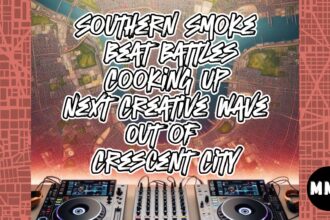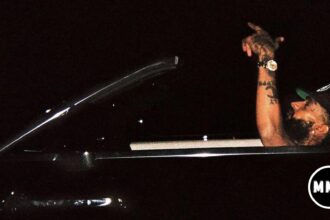I have over 100 records in my house. I seldom listen or even look at them. Still, few things get me as excited as opening the door to a record store and devoting the next three hours to sifting through shelves of music. I love the journey, but it’s a journey with no destination, one I don’t fully understand and still choose to pursue.
First, a very brief history interlude. In 1877 Thomas Edison recorded a brief recital of “Mary Had a Little Lamb” onto a makeshift audio device. The concept of audio, or a recording in general, was unheard of until this point. Almost 150 years later, over a billion records have been recorded and sold across all genres and types of artists. During this time, the science of music listening has been innovated and nearly perfected. As we’ve progressed from cassettes to CDs, to online streaming, listening to music has become more accessible and convenient than ever.
Despite this innovation, in recent years physical vinyl record sales have reached an all-time high. Record shelves are being lovingly packed in a way we haven’t seen since their initial drift away from mainstream culture.
Vinyl collecting is at a modern peak; with new record stores sprouting up across the country touting a variety of vintage tracks and new releases, all in the “outdated” physical form. As this trend continues, the increase in online music streaming does as well. People consume music on digital platforms such as Spotify, Apple Music, and YouTube more than they do any other outlet.
These two coinciding developments have left us with a strange culture of music consumption; we’re buying physical records then streaming the same songs we just bought on our way home. I’m just as guilty of this as everyone else. Even at this exact moment, I’m listening to “Sunny Afternoon” by The Kinks on Spotify, knowing full well that their album, Face to Face, is sitting in the next room waiting to be spun (for deeper Kinks content, check out my music festival draft with Nate Monschein).
I spoke to a few local record collectors to find out if I was in the minority on this sentiment. Some seemed to disagree.
“I think there is something special about listening to a record rather than using your phone because it feels more personal and warm. It’s a way to bring back the classic and original way of listening to music, and force you to listen to the whole album instead of skipping songs.” —Louisa Hernandez, avid record collector.
It’s true that the vintage aesthetic and ritual of buying and listening to a record is part of the massive appeal. Maybe this historical aspect is what has pushed the industry ahead while preventing similar resurgences from CDs and cassette tapes. Maybe the popularity cycle will eventually hit the others as time goes on, similar to fashion.
The vintage aesthetic in question reaches beyond the simple age of the product. Some music aficionados swear by the grittier sound quality of records. There’s an alleged fuller and healthier sound to the music that can’t be found in digital form, even with the most expensive speakers.
The record store phenomenon might still exist no matter what trends pop up around it due to the novelty of the product itself. Where else are you going to find a 12”x12” physical manifestation of your favorite songs? This unique medium has struck a chord with every generation since its creation.
“I guess in a way they’re the new baseball cards. People collect them because they have some sort of value, whether it’s an unopened Nirvana “Bleach” vinyl or a record handed down through the family.” —Sayra Diaz De Niz, age 17, and an even more avid record collector.
Sayra is a fellow member of the youngest generation that’s just now beginning to take to record collecting. She brings up a valid point, reasoning that behind this current influx in record sales might also be the recent increase in popularity in the collector’s mindset of assigning value to otherwise insignificant objects.
This concept is a microcosm of a culture that values the ownership of an item over the service that the item provides. I could easily queue up Springsteen’s “Dancing In The Dark” digitally and watch him groove with Courtney Cox on stage. But there’s something special about holding a square cardboard cutout of The Boss’ denim backside, knowing that his greatest album is burned onto a disc inside. It’s an indescribable feeling of worth, despite the somewhat acknowledged lack thereof.
Our history of unfounded assigned values has never been on display more than in 2021. Even if you ignore the Pokémon and basketball card crazes of the pandemic, the world of collecting is reinventing itself. In just the first half of this year, NFTs have been sold for over 2.5 billion dollars collectively. For those unaware, NFT stands for “non-fungible token”.
They are essentially the same as typical expensive art pieces bought and sold by dealers around the world, with one catch—they’re entirely digital. You read that right, NFTs do not physically exist in the real world, yet many people are valuing them as they would a tangible art piece.
The conversation about why art holds any monetary value outside of the artist’s individual merit is enough to warrant its own article someday. However, it’s indisputable that the market for such items is fully established and growing every second. An NFT could be anything from a virtual signature to an original viral video. You could still view the signature or watch the video featured in the NFT, but it’s the supposed ownership of such an item that entices buyers.
A similar mentality is shared by many record collectors. Songs can be found through a split-second search on any given internet platform. However, for some collectors, the knowledge that you have a real-world copy of what you see on the internet or TV will always be intriguing.
Sometimes, the economics of the music business is irrelevant to the buyer. Records are a fantastic way to feel connected to an artist or band by showing your appreciation to them and their content by purchasing their product.
“Buying a record after you’ve gotten familiar with that album through streaming feels like a trophy of how much you love the album. Not only did you enjoy the album digitally, you took the initiative to go to a record store to buy something that’s easier to stream.” —Will Linton, you guessed it – an avid record collector.
Will’s perspective represents a vast majority of the recent wave of record buyers, collectors, and sellers. Most of the time, buying a record can be seen as a token of your gratitude to the artist or store for the work they’ve done and released.
So…why do we still buy records? I’m still just as confused about the answer as I was before I started this piece. They’re outdated, overpriced, and objectively inefficient.
They’re also really fun to look at, talk about, and collect. The most boring answer I could give to all of this is “I don’t know, but it sure is fun.” It’s an admitted cop-out but the best option as of now.
Records will never die and neither will their fanbase of music lovers. I could list a million reasons not to purchase a record and still find myself waltzing up to the front desk of Josey Records in Dallas with a handful of late ‘70s funk or early 2000s hip-hop vinyl. At the end of the day, it’s just another reason to go out, make new friends, and talk about music. Don’t overthink it.










My brother contends that the sound of music from a record is warmer than that from a CD or a streaming platform. One of my fondest memories of the year I spent studying in Oxford, England, was being able to go into a record store, sit in a small compartment, and listen to records I wanted to try out. Bliss!